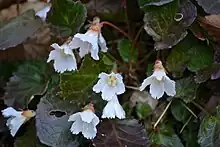Shortia
Shortia is a small genus of subshrubs or perennial herbs in the family Diapensiaceae. There are five species, four in Asia and one in the Appalachian Mountains of eastern North America.[1] They are found in mountainous areas, generally from 1,000–2,000 metres (3,300–6,600 ft) elevation.[2] All have restricted ranges and are generally considered rare. Three of the species, S. galacifolia, S. soldanelloides, and S. uniflora are often cultivated. The genus was by Asa Gray named after botanist Charles Wilkins Short. In Gray's diary entry for April 8, 1839, he named the genus after Charles Wilkins Short because the plant was native to America in a region close to where Short lived, which was Kentucky. Short and Gray never met but they corresponded with one another frequently. Short never saw a live nor dried specimen of his namesake genus.[3][4]
| Shortia | |
|---|---|
 | |
| Shortia galacifolia | |
| Scientific classification | |
| Kingdom: | Plantae |
| Clade: | Tracheophytes |
| Clade: | Angiosperms |
| Clade: | Eudicots |
| Clade: | Asterids |
| Order: | Ericales |
| Family: | Diapensiaceae |
| Genus: | Shortia Torr. & A.Gray |
| Type species | |
| Shortia galacifolia | |
Species
| Image | Name | Distribution |
|---|---|---|
| Shortia exappendiculata Hayata | Taiwan | |
 | Shortia galacifolia Torr. and Gray | southeastern United States, North and South Carolina and Georgia |
| Shortia sinensis Hemsley | China, mountains of southeast Yunnan | |
| Shortia soldanelloides (Siebold & Zuccarini) Makino | Japan, southern Hokkaido through Honshu and Kyushu to Yakushima | |
 | Shortia uniflora (Maximowicz) Maximowicz | Japan, northern Honshu |
References
- Rönblom, K. & A.A. Anderberg (2002). "Phylogeny of Diapensiaceae based on molecular data and morphology". Systematic Botany. 27 (2): 383–395. doi:10.1043/0363-6445-27.2.383.
- Barnes, P. "A Summary of the genus Shortia (Diapensiaceae)".
- "Shortia galacifolia". Lady Bird Johnson Wildflower Center. Retrieved January 1, 2015.
- Jenkins, Charles F. (1942). "Asa Gray and his Quest for Shortia galacifolia". Arnoldia. 2 (3 & 4): 13–28. JSTOR 42953488.